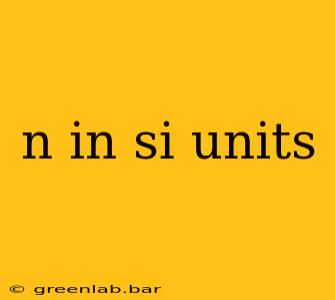The lowercase 'n' in SI units represents the amount of substance, measured in moles (mol). While seemingly simple, understanding the implications of 'n' and its role in various scientific calculations is crucial across numerous disciplines, from chemistry and physics to materials science and engineering. This article will delve into the meaning of 'n', its significance, and its practical applications.
What is a Mole (mol)?
Before exploring 'n', we need to grasp the fundamental concept of a mole. A mole isn't a furry creature; instead, it's a unit representing a specific number of particles—atoms, molecules, ions, or even subatomic particles. This number is Avogadro's number, approximately 6.022 x 1023. Think of it like a dozen (12) but on a vastly larger scale, relevant to the microscopic world.
One mole of any substance contains Avogadro's number of constituent particles. For example:
- 1 mol of carbon atoms contains 6.022 x 1023 carbon atoms.
- 1 mol of water molecules (H₂O) contains 6.022 x 1023 water molecules.
The Significance of 'n' in Calculations
The 'n' representing the amount of substance in moles serves as a crucial link between the macroscopic world (grams, liters) and the microscopic world (atoms, molecules). It appears prominently in various equations, including:
1. Ideal Gas Law:
The ideal gas law, PV = nRT, perfectly illustrates the role of 'n'. Here:
- P represents pressure.
- V represents volume.
- R is the ideal gas constant.
- T represents temperature.
'n', the number of moles, connects the macroscopic properties (P, V, T) with the microscopic amount of substance. Knowing 'n' allows for accurate calculations of pressure, volume, or temperature under specific conditions.
2. Molar Mass Calculations:
Molar mass (M) is the mass of one mole of a substance. The relationship between mass (m), amount of substance (n), and molar mass (M) is:
m = n * M
This simple equation allows us to determine the mass of a substance given its molar mass and the amount of substance (or vice-versa). For instance, if we know we have 2 moles of water (n = 2 mol) and the molar mass of water is 18 g/mol (M = 18 g/mol), we can calculate the mass (m) as 36 grams.
3. Stoichiometry:
In chemical reactions, 'n' is essential for stoichiometric calculations. Balanced chemical equations provide mole ratios between reactants and products. Using these ratios and the amount of substance (n) of a reactant, we can predict the amount of substance of products formed or reactants consumed.
Beyond Basic Applications: Advanced Uses of 'n'
The concept of 'n' extends beyond simple calculations. It's crucial in:
- Thermodynamics: Determining the number of moles is vital for calculating entropy, enthalpy, and Gibbs free energy changes in chemical and physical processes.
- Electrochemistry: Faraday's laws of electrolysis utilize 'n' to relate the amount of substance deposited or liberated during an electrochemical reaction to the charge passed.
- Nuclear Chemistry: In nuclear reactions, 'n' can represent the amount of substance of radioactive isotopes, crucial for determining decay rates and half-lives.
Conclusion: The Ubiquitous 'n'
The seemingly simple 'n' in SI units, representing the amount of substance in moles, is a powerful tool connecting the macroscopic and microscopic worlds. Its understanding is fundamental to numerous scientific and engineering calculations across diverse disciplines. Mastering its application opens doors to a deeper understanding of chemical reactions, physical processes, and many other natural phenomena.

